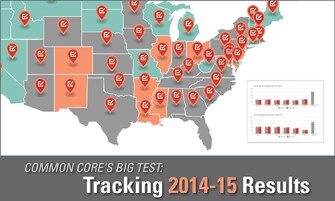More than half the states have made their tests more difficult to pass, bringing proficiency rates more closely into line with the those of the rigorous National Assessment of Educational Progress, or NAEP, according to a study released Thursday.
The analysis, by Achieve and the Collaborative for Student Success, is the second this week to report that states are setting performance expectations in math and English/language arts that are closer to those on the NAEP. On Wednesday, Harvard University researchers published a similar study in the journal Education Next, showing states requiring higher-caliber performance on state tests for students to be deemed “proficient.”
Here at EdWeek, we’ve been reporting those patterns since last November, when we published Education Week‘s national database of states’ 2014-15 test scores. It shows big drops in proficiency rates as many states switched to tests aligned with the Common Core State Standards. The map has been updated as states report results.

The higher expectations for test performance go hand-in-hand with the learning outlined in the Common Core State Standards, adopted by more than 40 states. The two federally funded consortia that designed tests for those standards, PARCC and Smarter Balanced, deliberately aimed higher when they were setting cut scores for proficiency on their tests, as we’ve reported.
Raising Performance Expectations
The Achieve report is an update of its work last May, when it reported that more than half the states had a 30-point differential between the proportions of students that scored proficient on 2013-14 state tests and on the 2013 NAEP. The new report compares proficiency rates on state tests in 2014-15 to those on the fall 2015 NAEP in 4th grade reading and 8th grade math. It dubbed that differential “the honesty gap.”
In the new report, Achieve found that 26 states narrowed those gaps by 10 percentage points or more in either 4th grade reading or 8th grade math. Sixteen states erased, or nearly erased, the gaps between their own proficiency rates and those on NAEP in one or both subject areas by narrowing the gaps to 5 percentage points or less. (See the report, “Proficient vs. Prepared,” for the full list of states’ gaps in both subject areas.)
Three states—Massachusetts, New York, and Utah—earned particular praise for having NAEP-like expectations in both subject areas. New York’s expectations are even higher than NAEP’s: Proficiency rates on its state tests in 4th grade reading and 8th grade math are 3 to 10 percentage points lower than its proficiency rates on the NAEP, Achieve reports.
The report calls out four states with particularly big gaps between their definition of proficiency and the NAEP’s: Texas, Iowa, Oklahoma, and Virginia. Texas was the biggest offender, with gaps of more than 40 points between its own proficiency rates and those on the NAEP. (By deadline time, Texas officials had not returned a call seeking comment.) Since 2011-12, Texas has been planning to phase in higher cut scores on its state tests, but delayed that move until 2015-16.
EdWeek’s test-results database shows that in 2014-15, 7 in 10 Texas students performed at the proficient level or higher on state tests in math, and three-quarters did so in English/language arts. On the 2015 NAEP, however, the proficiency of Texas students ranged from 32 percent to 44 percent in math and 28 percent to 31 percent in reading.
Leaving ‘the Land of Proficiency’
Two states—Georgia and Arkansas—got back slaps from Achieve for making the biggest change in their expectations of what constitutes “proficient” performance on math and English/language arts tests. Georgia had a 60 percentage point gap in 2013-14, but in 2014-15 it narrowed that gap to only 3 percentage points.
EdWeek‘s test-results database shows that 81 percent to 88 percent of students performed at proficient or higher on Georgia’s 2013-14 math tests, and 88 percent to 97 percent performed at that level in English/language arts. On new tests designed for 2014-15, however, Georgia’s proficiency rates hovered in the 30s. On the 2015 NAEP, Georgia turned in proficiency rates of 28 percent to 34 percent.
Melissa Fincher, Georgia’s assessment director, said it hasn’t been easy to watch student proficiency rates drop. But she and other state leaders believed it was necessary to provide the public with a more truthful story of how their schools are doing.
“I used to refer to Georgia as the land of proficiency: Come to Georgia and you, too, will be proficient,” Fincher joked, referring to the old test’s high proficiency rates. “But really, we needed to make a change. It was time to recalibrate our expectations and be very thoughtful about what we wanted our students to achieve. Clearly, our students need to be competitive with their peers around the country.”
See also:
